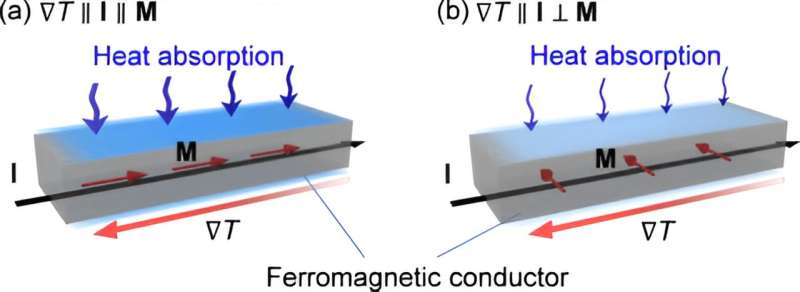Schematic diagram of cooling caused by the anisotropic magnetic Thomson effect. Credit: Physical Review Letters (2023). DOI: 10.1103/PhysRevLett.131.206701
Japan’s National Institute of Materials Science (NIMS) has successfully directly observed the “anisotropic magnetic Thomson effect,” a phenomenon that refers to anisotropic changes in heat absorption/release in proportion to the applied temperature difference and charging current. phenomenon (i.e. Thomson effect). The direction of magnetization of a magnetic material.
This research is expected to further advance fundamental physics and materials science related to the converging fields of thermoelectrics and spintronics, as well as develop new capabilities for controlling thermal energy with magnetism.The research is published in the journal Physical Review Letters.
The Thomson effect has long been recognized as one of the fundamental thermoelectric effects in metals and semiconductors, along with the Seebeck effect and the Peltier effect, both of which are driving principles for thermoelectric conversion technology.
Although the influence of magnetism on the Seebeck effect and Peltier effect has been studied for many years, since the thermoelectric conversion of the Thomson effect is generally small, and its measurement and quantification, it has not yet been understood how the Thomson effect is affected by magnetic fields and magnetically affected. Estimation methods are not yet fully established.
In this case, NIMS reported in 2020 the results of an experiment in which it was observed that the Thomson effect in non-magnetic conductors changes with changes in the magnetic field (i.e., the magnetic Thomson effect).
This time, researchers successfully observed the anisotropic magnetic Thomson effect in magnetic materials through more precise thermal measurements. The anisotropic magnetic Thomson effect in magnetic materials is different from the conventional magnetic Thomson effect in non-magnetic materials, and this is the first time this unexplored phenomenon has been directly observed.
The NIMS research team used a thermal measurement technique called lock-in thermography to precisely measure the temperature distribution produced when charging current is applied to the ferromagnetic alloy Ni95platinum5 A temperature difference was simultaneously applied and it was verified how the Thomson effect changes depending on the magnetization direction.
It was found that the amount of heat absorbed (or released) generated in Ni95platinum5 The alloy is larger when the temperature gradient and charging current are parallel to the magnetization than perpendicular to the magnetization. This result is consistent with the behavior expected from measurements of the Seebeck and Peltier effects in magnetic materials.
This study elucidates the basic nature of the anisotropic magnetic Thomson effect and establishes its quantitative measurement technology. In the future, researchers will continue to explore the physics, materials and functions of the anisotropic magnetic Thomson effect, study new physics caused by thermal, electrical and magnetic interactions, and develop applications of thermal management technology to help improve the efficiency of electronic devices and energy saving.
This project is implemented by Rajkumar Modak (Special Investigator, Center for Magnetic and Spintronic Materials Research, NIMS), Takamasa Hirai (Investigator, CMSM, NIMS), Seiji Mitani (Director, CMSM, NIMS), and Ken-ichi Uchida (Distinguished Group Leader, CMSM , NIMS).
More information:
Rajkumar Modak et al., Observation of the Anisotropic Magnetic Thomson Effect, Physical Review Letters (2023). DOI: 10.1103/PhysRevLett.131.206701
Provided by National Institute of Materials Science
citation: Controlling thermoelectric conversion in magnetic materials through magnetization direction (2023, December 22), Retrieved December 22, 2023, from https://phys.org/news/2023-12-thermoelectric-conversion-Magnetic- materials-magnetization.html
This document is protected by copyright. No part may be reproduced without written permission except in the interests of fair dealing for private study or research purposes. Content is for reference only.
#Controlling #thermoelectric #conversion #magnetic #materials #magnetization #direction
Image Source : phys.org
